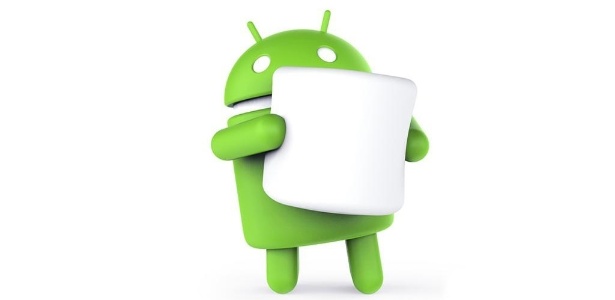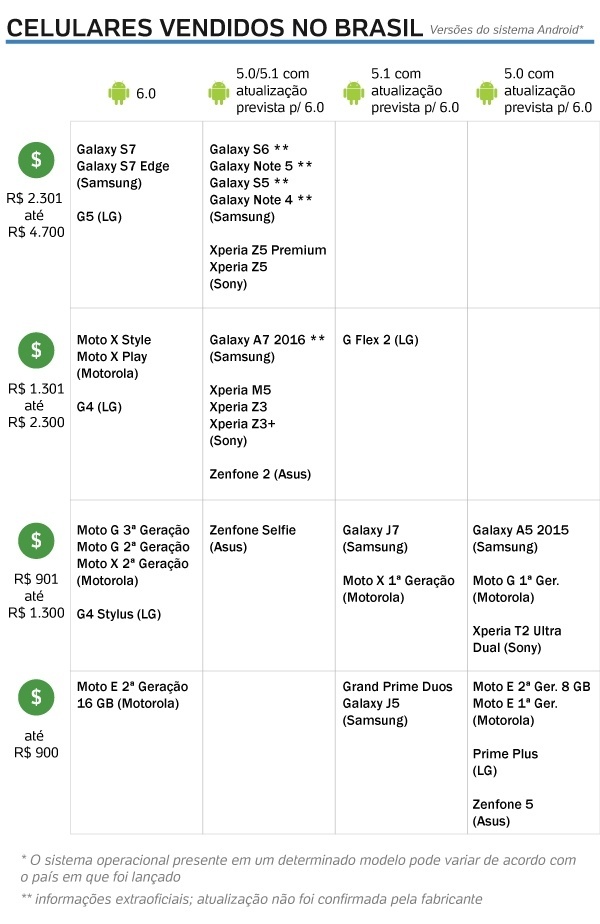-
Disclosure

If you are the owner of a smartphone or tablet with Android should know that one of the biggest disappointments with the operating system is the delay to update it to the latest version. In case it is 6.0 named Marshmallow, which was launched by Google in October last year. But recently the company released the previous version, the Lollipop (5.0 and 5.1) is that it is the most used in the world today.
Lollipop, representing 36.1% of the market, only got that post now, 16 months after its launch. Already the percentage of devices with Marshmallow is a measly 2.3%. Although that number should grow –já that manufacturers are still updating their modelos–, the responsibility for slow release of upgrades is not unique to Google, but a process involving the manufacturers and even operators.
the effort might be one step closer to being outdated, as a new version of Android, provisionally called N, is already testing for developers and should be released probably in the second half.
Why is it important to update the operating system of your device? In addition to a new version to solve important issues of security and performance, they bring new features. Marshmallow, for example, comes with Now on Tap –that improves personal assistant Google Now–, payment with fingerprint and a way of advanced energy saving, among others.
The manufacturers via rule adopts the following position on this issue: update to the latest operating system only top of the line appliances and hopefully, some of the middle line. Input cell, no way. And the few who earn the new Android end up waiting months to receive the update. The time varies according to the country where the model was launched.
It also occurs that newer devices just “sticking the queue” and now come standard with the new Android. In 2016, examples of this are the recently launched Galaxy S7 and S7 edge, Samsung. The G5, top of the line LG, due in stores in April and will come with Android 6.0.
One of the examples that are beyond the rule is Motorola, which has updated its entire line of devices with Android 6.0. The exception are some models of Moto E with 8 GB of internal memory, which could not bear to run the system. The Droid Turbo, launched in 2014, is another who does not have the Marshmallow, but the company says it is working on updating.
Anatomy of a system
The factors that influence the delay of the update are many. Most of them are technical, as there are many steps so that they get to the owners of a device with Android.
Soon after the announcement of a new Android, the system source code is sent for evaluation of chips and cell manufacturers. They will see which processors and devices from your line have the minimum capacity to run the system. After each manufacturer makes the necessary customizations to the system, including own resources and sometimes changing part of the visual identity. The result of Android adapted is called “skin”.
Another important step goes through the locked handsets to operate on a telephone operator, who need to make adjustments to their devices. Are incorporated more changes to the telephony bands work well in the system.
It is common for unlocked phones to be updated before they were purchased under contract with operators. Not only the question of testing, but because some apps that come standard (and can not be deleted) are owned by the telephone company and may need to be updated to not cause conflicts in the new system. It is what he has heard the report by questioning TIM, Claro, Vivo and Hi on the subject, dividing sometimes this “guilt” with the manufacturers.
“The own applications operators demand development, the manufacturer cell, a specific software version. it is part of this process perform tests to validate the updates, seeking to ensure the optimal functioning of devices and maintain the quality of connection to the network, “said the official response of the TIM. “Each manufacturer operates a specific rule for updates. The period for the release reaches the customer depends on the interval at which new versions are appropriate to the various device models,” said Vivo.
After step operators, tests are performed; if errors are found, they go back to change phase. If everything is right, the next step is the certification with regulatory authorities in each country and Google itself. If approved, the final step is to send the update “over the air” (via wi-fi in Android itself) or by the manufacturer itself management programs.
Money also influences?
commercial reasons may also make a difference. He says Van L. Baker, Gartner consultant specializing in the mobile market:. He believes it is not advantageous for manufacturers and operators to advance in the race for upgrade because it is not something advantageous for them
“At launch system, the manufacturer has to make the decision to want to do it. they need to make changes in their skins, submit it to the operators, which have their own processes and need to check whether they are comfortable to release it on their devices. this process will against the interests of the operators or manufacturers because instead of updating the phones that you have, they will want you to buy a new device, “he says.
He also cites the instability of the Android system as another factor complicating the process. “Most Android users who try to use the new versions is a problem in it. It is very rare that a new version works well on all devices,” he argues.
The manufacturers, in turn, disagree and they say do what they can to upgrade as soon as possible the greatest number of devices, although it is very difficult to find in their sites information on which models have or will have updates.
Motorola defends his stance use Android without much interference from the manufacturer as an important factor for progress in this regard updates. And when they add things, it is to try to bring advantages to users. “The Moto X was first product to bring voice commands without touching the device, and this feature has improved independent of the Android upgrade. The camera Moto G has evolved quite well,” says Renato Arradi, Motorola product manager.
Other manufacturers heard point operators as it takes the co-authors. “As manufacturers, testing the updates in their products, operators also have an approval process to ensure smooth operation on its own network. Sony cherishes the user experience, and for this reason the brand only releases Android update when you are 100% satisfied with the result, “said the statement sent to Sony UOL .
LG will on the same line. “This process depends not only on release of LG, but also an adaptation by operators. LG is one of the companies most concerned with operating system upgrade of smartphones and care in carrying out a process which ensures maximum quality software upgrade to a premium experience of our customers. “
Sought, Samsung and Google did not respond to the report.

No comments:
Post a Comment